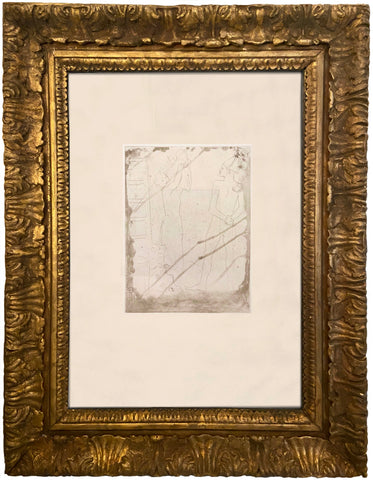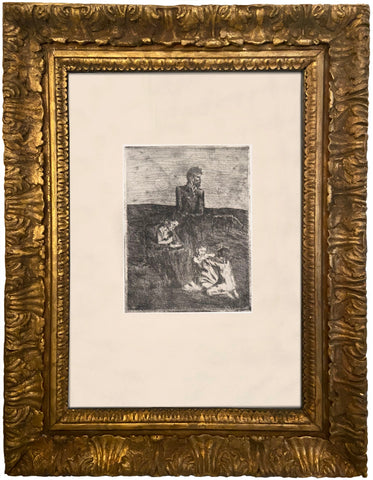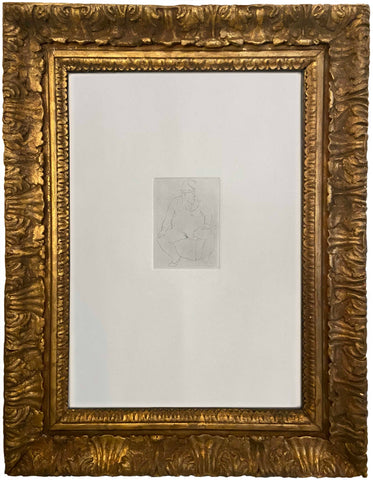Raphaël et la Fornarina XXII
€9,000.00
This product is currently sold out.
Title: Raphaël et la Fornarina XXII
Medium: Original Acquaforte
Serie: 347
Year: Dated 08 September 1968
Edition: 50
Publisher-editor: Published by Galerie L. Leiris, Paris, 1969
Bibliograph/Published: Bloch. 1797; Baer. 1814
Sizes: 15 x 20cm (plate) 30 x 35 cm (paper)
Signature: Signed on pencil
This work is sold unframed
Pablo Picasso, at the age of 87, created 347 etchings during a span of only six months. This prolific output is quite amazing given his age and the short time period; however his technical skill and artistic faculties were still extraordinary and the series is highly regarded for it's artistic creativity and merit.
While discussing his 347 Series with his friend, Roberto Otero, to whom he had shown some of these etchings, Picasso said, “Of course, one never knows what’s going to come out, but as soon as the drawing gets underway, a story or an idea is born. And that’s it. Then the story grows, like theater or life—and the drawing is turned into other drawings, a real novel. It’s great fun, believe me. At least, I enjoy myself no end inventing these stories, and I spend hour after hour while I draw, observing my creatures and thinking about the mad things they’re up to. Basically, it’s my way of writing fiction.” (Roberto Ortero, Forever Picasso: An Intimate Look at his Last Years, New York, 1974, p. 170)
Six months later, Picasso said the following about the prospective publication of the 347 series to Otero:
“You know, Louise Leiris is about to exhibit my latest engravings. And there’s one series that is quite innocent—I mean, quite natural. Well, you can imagine what they are about: Raphael and La Fornarina—his famous model—making love. Well, there’s no need to exaggerate—it’s not all sex, Raphael is painting in many of them, too—but Michelangelo is also there, spying on them from behind the draperies or under the bed. And sometimes the Pope is peeping through the keyhole, or some other important character is lurking about.” (Roberto Otero, pp. 178-9)
Raffaello Sanzio da Urbino, known simply as Raphael, was born on either April 6 or March 28, 1483 and died at the age of 37 on April 6, 1520. He was an Italian painter and architect of the High Renaissance and although he never married, in 1514 he did became engaged to Maria Bibbiena, Cardinal Medici Bibbiena's niece. Raphael died six years later without ever having married. He was said to have had many affairs, but a permanent fixture in his life in Rome was "La Fornarina," whose name was Margherita Luti, the daughter of a baker (fornaro) named Francesco Luti from Siena who lived at Via del Governo Vecchio. Raphael painted her nude portrait entitled "La Fornarina (The Baker's Daughter)" between 1518 and 1520 and the work is currently in the Galleria Nazionale d'Arte Antica in Palazzo Barberini, Rome.
The story of Raphael's legendary love for his model inspired another artist Ingres to paint a portrait (around 1814) depicting Margherita Luti sitting on Raphael's lap as he gazes at the "La Fornarina" portrait painting in progress; having apparently taken a break from his work to make love to his beautiful model. In the background was painted a drawn back curtain revealing a view of the Vatican through the window and behind the easel a hand is holding a copy of Vasari's "Life of Raphael." The man with the book behind the easel is Ingres himself, reading between the lines of Raphael's relationship with his model.
In 1968, Pablo Picasso pays homage to both Raphael, and in particular Ingres, within the 347 etching series. There are no less then 25 works depict the alleged story of the infamous 16th century affair between Raphael and his famous muse. This work for sale is the 24th of the "Raphael and Fornarina" series and depicts a love scene between the artist and his model. While engaged, Raphael clasps his paint brush in one hand and his artists pallet in the other. In addition, the theme of voyeurism is explored; under the bed can be seen, peeking out and watching cautiously, the face of another famous Renaissance artist Michelangelo. In addition, Piero Crommelynck, the Master Printer and friend of Picasso, strolls into the bedroom looking very straight laced has he peels back a curtain and looks onto the scene of eroticism unfolding before him.







